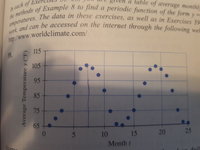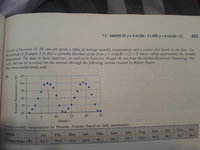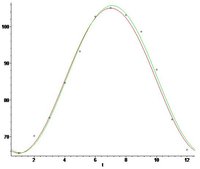Technically speaking, it's the
results of monthly work (done by the Earth and Sun) that we're trying to approximate.

Perfect.
D is easy to calculate at any stage in the exercise. I generally find D right after A because the calculation is similar.
D is the average of the maximum and minimum values of y.
Let's go over A and D, a bit. Recall the shape of the graph of y=sin(x). It oscillates above and below the x-axis. The wave shape is symmetrical, and the x-axis runs through the middle of the wave, dividing it into an upper half and lower half. We call such a dividing line the 'midline'. Therefore, the peaks are the same distance above the midline as the valleys are below it. That distance is A (the amplitude parameter).
That's why we take the total difference from the top of the peak to the bottom of the valley (105.1-65.5) and divide it by 2; half that distance is above the midline, and half is below. That's how A is related to the midline.
D is related to the midline, also. D is the vertical-shift parameter. Thinking about y=sin(x) again, the midline lies on the x-axis, and the wave bounces up and down between y=-1 and y=1. In this thread, the midline has been shifted vertically upwards, and the wave bounces up and down between y=65.5 and y=105.1. The midline is in the middle; therefore, D needs to be halfway between 65.5 and 105.1, and the value halfway between two given numbers is always their average.
D is the average of the maximum and minimum values of y.
Perfect.
The phase shift is the horizontal shift. The following is review, from a previous thread, where we talked about the interesting points of y=sin(x), over the first period. Those five points are the Origin (left end of the period), the maximum (1/4th of the way through the period), the axis intercept (1/2 way through the period), the minimum (3/4ths of the way through the period) and the next axis intercept (right end of the period). This pattern is the same for all sine waves that do not have a phase shift (i.e., have not been shifted horizontally).
So, here's how we determine C/B (the distance to shift the graph). We know from the data that the first maximum occurs when t=7 (July). We know from the pattern just discussed that the first maximum (before a function is shifted) occurs 1/4th of the way through the period. We compare these two locations (the unshifted and shifted maximums), to see how far apart they are (the shift amount).
The period is 12, and 1/4th the distance from t=0 to t=12 is t=3. In other words, without a phase shift, the first maximum will occur at t=3 instead of t=7. Therefore, the required shift (from 3 to 7) is 4 units to the right.
The phase shift (C/B) needs to be 4, and you already know B. Solve for C.
C/B = 4
After you substitute all parameter values in the form y=A∙sin(B∙t-C)+D, try substituting some t-values from the chart, to see how close the function approximates the corresponding temperatures.
?




